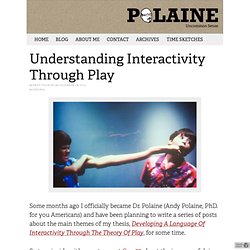

Game Architecture: Delivering Meaningful Learning Experiences by Mayra Aixa Villar. “I think that the lens or considerations that Schell thoroughly describes in his book could be used to analyze a broader spectrum of applications—not just games—and could be the foundation to define the structure of your next project, either an educational game or a course.

His guidelines can be very useful as a way to assure that your product delivers the experience for which you designed it.” Recent research has challenged the traditional assumption that games are the antithesis of serious work (see the References at the end of this article). Some characteristics of games can be used creatively to close a knowledge gap, deliver skill training, or create a change of attitude by means of contextualized practice, invitation to action, and self-assessment of decisions. Therefore, games emerge as an interesting alternative to offer more meaningful and engaging learning experiences.
It’s all about creating experiences. Understanding Interactivity Through Play — Playpen. Some months ago I officially became Dr.

Polaine (Andy Polaine, PhD. for you Americans) and have been planning to write a series of posts about the main themes of my thesis, Developing A Language Of Interactivity Through The Theory Of Play, for some time. So to coincide with a post over at Core77 about the journey of doing a design PhD, this is the first installment to introduce the main themes and to provide a link to download the entire thesis (5.9MB). The background to doing the PhD was largely everything I had learned since the early Antirom days when we were trying to discover and uncover the essence of interactive media and really trying to understand what makes it different from other media.
At the same time I was getting more and more interested in storytelling and was fascinated by fact that great stories, regardless of their content and style, tended to adhere to clearly defined structures that had been honed over thousands of years. The key to the whole exploration is play. Clark Aldrich Designs: Using Serious Games and Simulations: A Quick and Dirty Guide. In This Post: Learn what simulations are and aren’t.Understanding where they fit in an organizations’ flow of skills.Learn best practices in designing and creating sims.

A good educational simulation may look a lot like a casual computer game. It may have stylized, fast moving graphics. There may be a timer during some part of a level, and exaggerated consequences of failure. The person engaging the sim may look very much like a gamer, hunched over with a hand tightly grasped on the mouse and eyes riveted on the screen. This has led to a lot of people to erroneously conclude that the primary point of sims is to "make content enjoyable" often (a skeptic may further and logically intuit) at the expense of depth and flexibility while increasing of cost of production and time to “play.”
Rather, the necessary goal of a well-designed sim-based program is to develop in the student a deep, flexible, intuitive, kinesthetic understanding of the subject matter. Forcing Repetition The Eight C’s. 6 Important Questions Answered About Learning Simulations. TeachThought recently spoke with Clark Aldrich, an enthusiastic advocate for new learning forms, and leading thinker on the power of learning simulations and author of Learning Online with Games, Simulations, and Virtual Worlds and Unschooling Rules: 55 Ways to Unlearn What We Know About Schools and Rediscover Education.

The goal of the conversation was to provide some background on learning simulations for educators who might be new to the idea, while offering additional context for those ready to push forward with early integration. Terry Heick, TeachThought: “What’s a learning simulation”? Clark Aldrich: A learning simulation is an experience designed to rigorously help users develop competence and conviction. A learning simulation is a combination of modeling elements, entertainment (or game) elements, and instructional (or pedagogical) elements.
Learning simulations historically have fallen into two categories. First, it can just be too hard. Too much back story? The More You Know: Making Decisions Interesting in Games. Stardock's Jon Shafer, who previously led development of Civilization V at Firaxis, explains how it's possible to create a game full of "very interesting and very difficult decisions.

" Knowledge is power. Game designers ignore this old adage at their own peril. As developers we want our games to empower people to live out their fantasies, but all too often the games themselves get in the way. Whether in games or in life, we've all experienced that uncomfortable feeling of having no idea what to do. Most games require players to make a vast number of decisions, and if they're not provided enough information to make those choices confidently, the end result is nearly always frustration.
In this article we'll examine in detail the role of information in games, why meaningful choices require context and the consequences of omitting it. A designer's goal is always to make every decision the player faces interesting. CMS.300 Introduction to Videogame Studies, Fall 2011. Creating a Game Design Document.